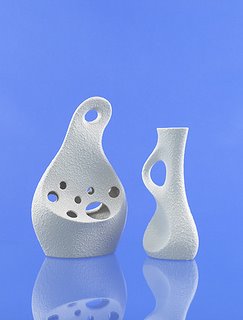 A Brief History of Sgrafo Modern Ceramics....
A Brief History of Sgrafo Modern Ceramics....Peter Müller was the owner of a small porcelain factory since1955. His partner was his brother Klaus. Initally, Peter Müller worked as a porcelain painter and as the company manager. The "Fabrik Feiner Kunstporzellane" factory was located in Höhr-Grenzhausen, a town in the middle of Germany (which is between Köln and Mainz). In a rather brief period of time Peter Müller created a small revolution and shifted the traditional production line towards more modern forms and designs. He developed a new technique of making porcelain in the process. He put two, to three layers of porcelain (with varying colours) on top of one another and then notched into the material. This method allowed the different colors of the layers to become visible. This patented technique is called sgrafo, and he was the only one who realized it in the 50s and 60s. The Sgrafo Modern designs have a unique style, which is very different from the other German porcelain products of the period. Sadly the company is no longer in business. Today, the successor of the factory is "ASA", also a factory with interesting designs, but there is no similarity to the old "Sgrafo" style. In 1995 Peter Müller retired. Today the special products of the 50s and 60s are highly sought after. Yet strangely enough, most people in Germany are unaware of the importance of Sgrafo Modern, because it was a small factory, and in the past there was only three or four big porcelain and ceramic factories, which flooded the market with their goods. At the time or course, not everybody responded to Peter Müller's designs, yet in retrospect he made some objects with wonderfully organically and imaginative forms Another aspect is, that the style of Peter Müller's products were between the style of ceramic and porcelain. German porcelain and ceramics had a more traditional style and only a few items were exported.
(this article was written and taken from the Axis Mundi Inc. website)
